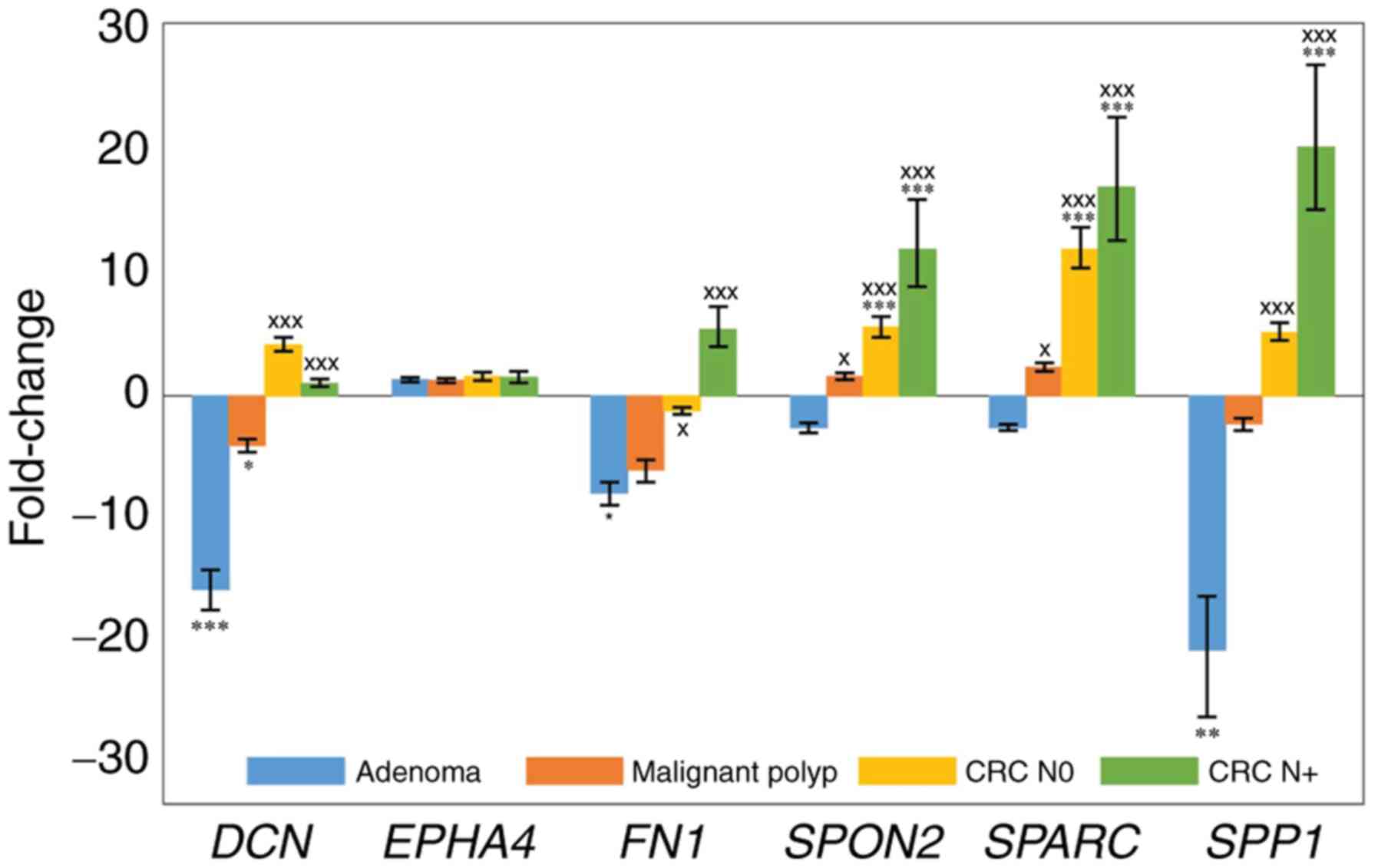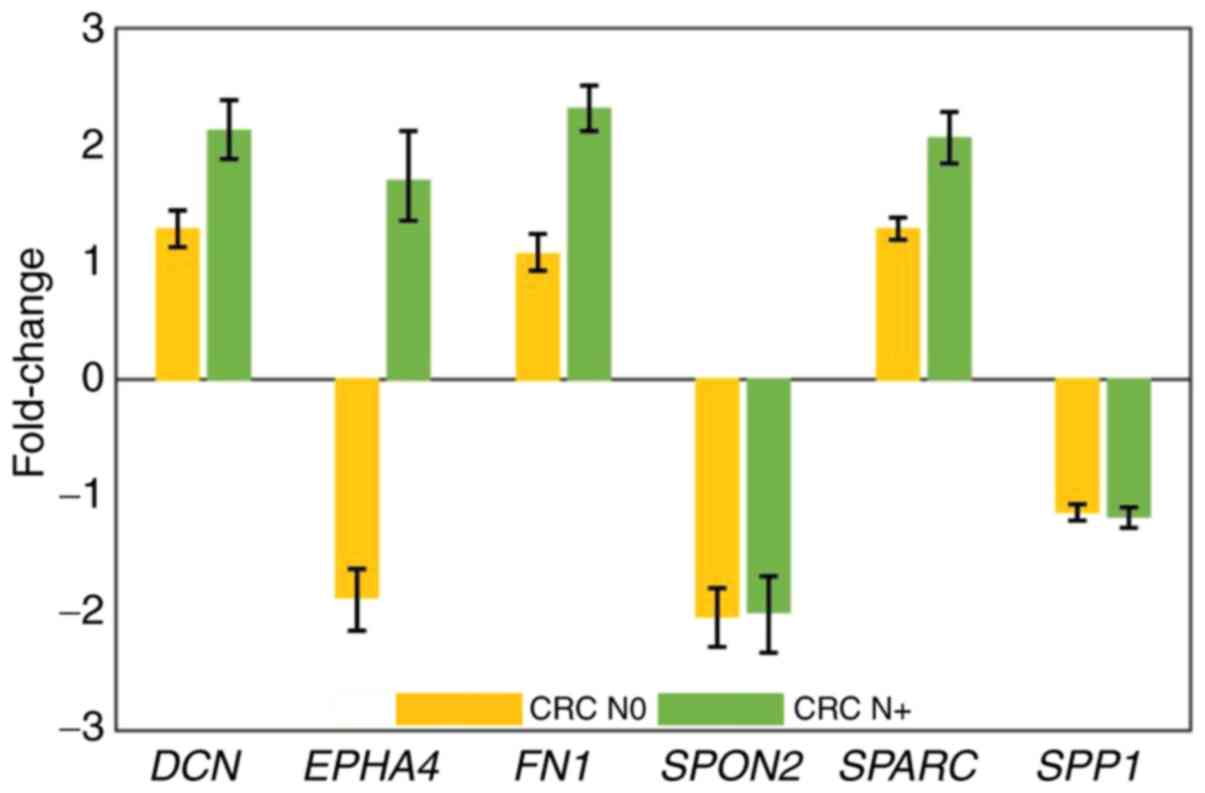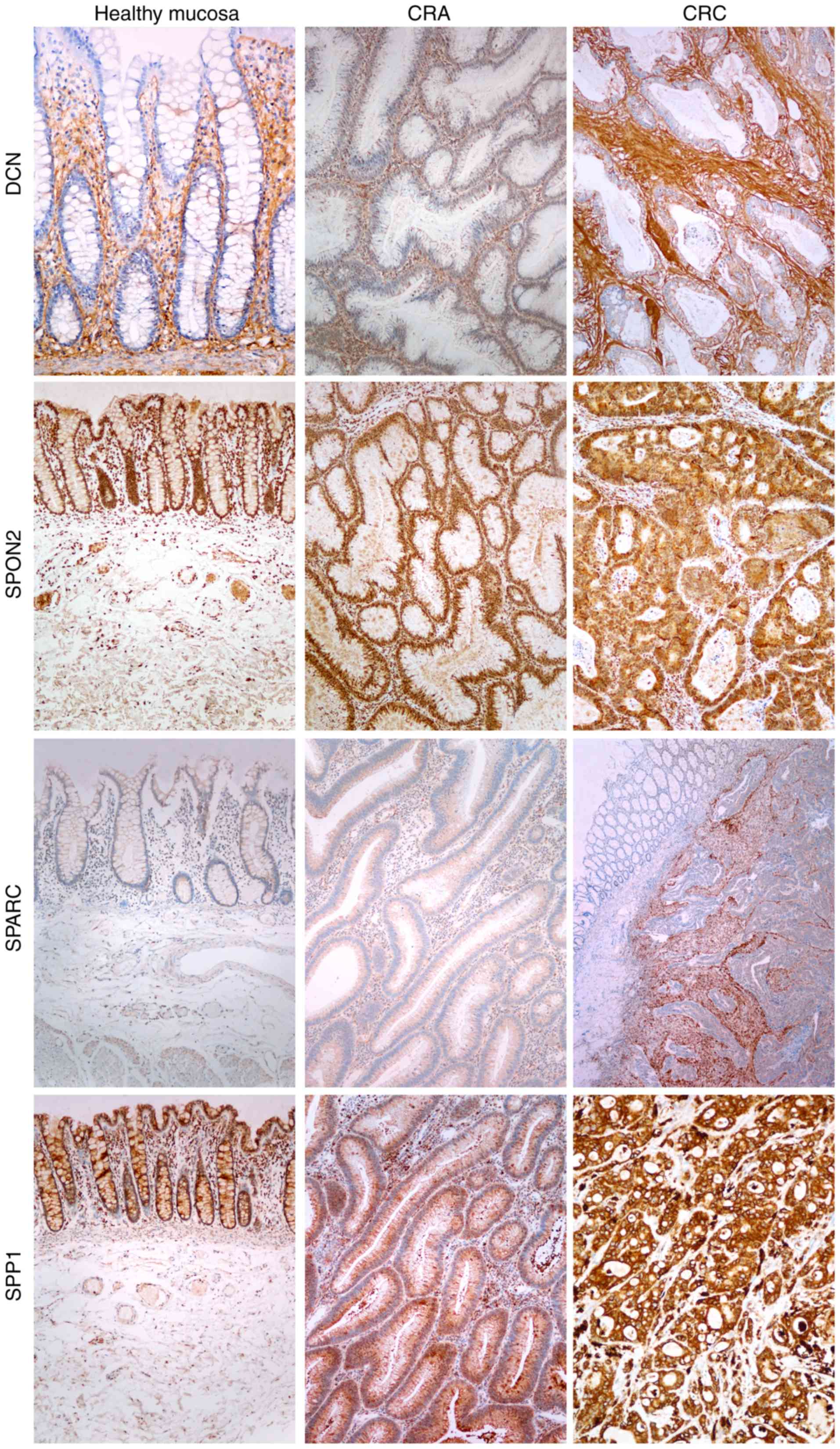|
1
|
Simon K: Colorectal cancer development and
advances in screening. Clin Interv Aging. 11:967–976. 2016.
View Article : Google Scholar : PubMed/NCBI
|
|
2
|
Mathonnet M, Perraud A, Christou N, Akil
H, Melin C, Battu S, Jauberteau MO and Denizot Y: Hallmarks in
colorectal cancer: Angiogenesis and cancer stem-like cells. World J
Gastroenterol. 20:4189–4196. 2014. View Article : Google Scholar : PubMed/NCBI
|
|
3
|
Kuipers EJ, Grady WM, Lieberman D,
Seufferlein T, Sung JJ, Boelens PG, van de Velde CJ and Watanabe T:
Colorectal cancer. Nat Rev Dis Primers. 1:150652015. View Article : Google Scholar : PubMed/NCBI
|
|
4
|
Shepherd NA and Griggs RK: Bowel cancer
screening-generated diagnostic conundrum of the century:
Pseudoinvasion in sigmoid colonic polyps. Mod Pathol. 1 (Suppl
28):S88–S94. 2015. View Article : Google Scholar
|
|
5
|
Griggs RK, Novelli MR, Sanders DS, Warren
BF, Williams GT, Quirke P and Shepherd NA: Challenging diagnostic
issues in adenomatous polyps with epithelial misplacement in bowel
cancer screening: 5 years' experience of the bowel cancer screening
programme expert board. Histopathology. 70:466–472. 2017.
View Article : Google Scholar : PubMed/NCBI
|
|
6
|
Panarelli NC, Somarathna T, Samowitz WS,
Kornacki S, Sanders SA, Novelli MR, Shepherd NA and Yantiss RK:
Diagnostic challenges caused by endoscopic biopsy of colonic
polyps: A systematic evaluation of epithelial misplacement with
review of problematic polyps from the bowel cancer screening
program, United Kingdom. Am J Surg Pathol. 40:1075–1083. 2016.
View Article : Google Scholar : PubMed/NCBI
|
|
7
|
Loughrey MB and Shepherd NA: The pathology
of bowel cancer screening. Histopathology. 66:66–77. 2015.
View Article : Google Scholar : PubMed/NCBI
|
|
8
|
Aghagolzadeh P and Radpour R: New trends
in molecular and cellular biomarker discovery for colorectal
cancer. World J Gastroenterol. 22:5678–5693. 2016. View Article : Google Scholar : PubMed/NCBI
|
|
9
|
Hauptman N, Boštjančič E, Žlajpah M,
Ranković B and Zidar N: Bioinformatics analysis reveals most
prominent gene candidates to distinguish colorectal adenoma from
adenocarcinoma. Biomed Res Int. 2018:94165152018. View Article : Google Scholar : PubMed/NCBI
|
|
10
|
Lu P, Takai K, Weaver VM and Werb Z:
Extracellular matrix degradation and remodeling in development and
disease. Cold Spring Harb Perspect Biol. 3:a0050582011. View Article : Google Scholar : PubMed/NCBI
|
|
11
|
Lu P, Weaver VM and Werb Z: The
extracellular matrix: A dynamic niche in cancer progression. J Cell
Biol. 196:395–406. 2012. View Article : Google Scholar : PubMed/NCBI
|
|
12
|
Venning FA, Wullkopf L and Erler JT:
Targeting ECM disrupts cancer progression. Front Oncol. 5:2242015.
View Article : Google Scholar : PubMed/NCBI
|
|
13
|
Pickup MW, Mouw JK and Weaver VM: The
extracellular matrix modulates the hallmarks of cancer. EMBO Rep.
15:1243–1253. 2014. View Article : Google Scholar : PubMed/NCBI
|
|
14
|
Fang M, Yuan J, Peng C and Li Y: Collagen
as a double-edged sword in tumor progression. Tumour Biol.
35:2871–2882. 2014. View Article : Google Scholar : PubMed/NCBI
|
|
15
|
Boudjadi S, Bernatchez G, Beaulieu JF and
Carrier JC: Control of the human osteopontin promoter by ERRalpha
in colorectal cancer. Am J Pathol. 183:266–276. 2013. View Article : Google Scholar : PubMed/NCBI
|
|
16
|
Imano M, Okuno K, Itoh T, Ishimaru E,
Satou T and Shiozaki H: Increased osteopontin-positive macrophage
expression in colorectal cancer stroma with synchronous liver
metastasis. World J Surg. 34:1930–1936. 2010. View Article : Google Scholar : PubMed/NCBI
|
|
17
|
Rohde F, Rimkus C, Friederichs J,
Rosenberg R, Marthen C, Doll D, Holzmann B, Siewert JR and Janssen
KP: Expression of osteopontin, a target gene of de-regulated Wnt
signaling, predicts survival in colon cancer. Int J Cancer.
121:1717–1723. 2007. View Article : Google Scholar : PubMed/NCBI
|
|
18
|
Galamb O, Sipos F, Spisak S, Galamb B,
Krenacs T, Valcz G, Tulassay Z and Molnar B: Potential biomarkers
of colorectal adenoma-dysplasia-carcinoma progression: mRNA
expression profiling and in situ protein detection on TMAs reveal
15 sequentially upregulated and 2 downregulated genes. Cell Oncol.
31:19–29. 2009.PubMed/NCBI
|
|
19
|
Valcz G, Sipos F, Krenacs T, Molnar J,
Patai AV, Leiszter K, Toth K, Solymosi N, Galamb O, Molnar B and
Tulassay Z: Elevated osteopontin expression and
proliferative/apoptotic ratio in the colorectal
adenoma-dysplasia-carcinoma sequence. Pathol Oncol Res. 16:541–545.
2010. View Article : Google Scholar : PubMed/NCBI
|
|
20
|
Augoff K, Rabczynski J, Tabola R, Czapla
L, Ratajczak K and Grabowski K: Immunohistochemical study of
decorin expression in polyps and carcinomas of the colon. Med Sci
Monit. 14:CR530–CR535. 2008.PubMed/NCBI
|
|
21
|
Liu QZ, Gao XH, Chang WJ, Wang HT, Wang H,
Cao GW and Fu CG: Secreted protein acidic and rich in cysteine
expression in human colorectal cancer predicts postoperative
prognosis. Eur Rev Med Pharmacol Sci. 19:1803–1811. 2015.PubMed/NCBI
|
|
22
|
Nyman MC, Sainio AO, Pennanen MM, Lund RJ,
Vuorikoski S, Sundström JT and Järveläinen HT: Decorin in human
colon cancer: Localization in vivo and effect on cancer cell
behavior in vitro. J Histochem Cytochem. 63:710–720. 2015.
View Article : Google Scholar : PubMed/NCBI
|
|
23
|
Cai X, Liu C, Zhang TN, Zhu YW, Dong X and
Xue P: Down-regulation of FN1 inhibits colorectal carcinogenesis by
suppressing proliferation, migration, and invasion. J Cell Biochem.
119:4717–4728. 2018. View Article : Google Scholar : PubMed/NCBI
|
|
24
|
Thorsen SB, Lundberg M, Villablanca A,
Christensen SL, Belling KC, Nielsen BS, Knowles M, Gee N, Nielsen
HJ, Brunner N, et al: Detection of serological biomarkers by
proximity extension assay for detection of colorectal neoplasias in
symptomatic individuals. J Transl Med. 11:2532013. View Article : Google Scholar : PubMed/NCBI
|
|
25
|
Wang S, Zhang C, Zhang Z, Qian W and Sun
Y, Ji B, Zhang Y, Zhu C, Ji D, Wang Q and Sun Y: Transcriptome
analysis in primary colorectal cancer tissues from patients with
and without liver metastases using next-generation sequencing.
Cancer Med. 6:1976–1987. 2017. View Article : Google Scholar : PubMed/NCBI
|
|
26
|
Zhang Q, Wang XQ, Wang J, Cui SJ, Lou XM,
Yan B, Qiao J, Jiang YH, Zhang LJ, Yang PY and Liu F: Upregulation
of spondin-2 predicts poor survival of colorectal carcinoma
patients. Oncotarget. 6:15095–15110. 2015.PubMed/NCBI
|
|
27
|
Zhao M, Liang F, Zhang B, Yan W and Zhang
J: The impact of osteopontin on prognosis and clinicopathology of
colorectal cancer patients: A systematic meta-analysis. Sci Rep.
5:127132015. View Article : Google Scholar : PubMed/NCBI
|
|
28
|
Sethi MK, Thaysen-Andersen M, Kim H, Park
CK, Baker MS, Packer NH, Paik YK, Hancock WS and Fanayan S:
Quantitative proteomic analysis of paired colorectal cancer and
non-tumorigenic tissues reveals signature proteins and perturbed
pathways involved in CRC progression and metastasis. J Proteomics.
126:54–67. 2015. View Article : Google Scholar : PubMed/NCBI
|
|
29
|
Oshima T, Akaike M, Yoshihara K, Shiozawa
M, Yamamoto N, Sato T, Akihito N, Nagano Y, Fujii S, Kunisaki C, et
al: Overexpression of EphA4 gene and reduced expression of EphB2
gene correlates with liver metastasis in colorectal cancer. Int J
Oncol. 33:573–577. 2008.PubMed/NCBI
|
|
30
|
Adany R and Iozzo RV: Hypomethylation of
the decorin proteoglycan gene in human colon cancer. Biochem J.
276:301–306. 1991. View Article : Google Scholar : PubMed/NCBI
|
|
31
|
Tang RY, Wang Z, Chen HQ and Zhu SB:
Negative correlation between miR-200c and decorin plays an
important role in the pathogenesis of colorectal carcinoma. Biomed
Res Int. 2017:10389842017. View Article : Google Scholar : PubMed/NCBI
|
|
32
|
Liang JF, Wang HK, Xiao H, Li N, Cheng CX,
Zhao YZ, Ma YB, Gao JZ, Bai RB and Zheng HX: Relationship and
prognostic significance of SPARC and VEGF protein expression in
colon cancer. J Exp Clin Cancer Res. 29:712010. View Article : Google Scholar : PubMed/NCBI
|
|
33
|
Heitzer E, Artl M, Filipits M, Resel M,
Graf R, Weissenbacher B, Lax S, Gnant M, Wrba F, Greil R, et al:
Differential survival trends of stage II colorectal cancer patients
relate to promoter methylation status of PCDH10, SPARC, and UCHL1.
Mod Pathol. 27:906–915. 2014. View Article : Google Scholar : PubMed/NCBI
|
|
34
|
Zhang S, Jin J, Tian X and Wu L:
hsa-miR-29c-3p regulates biological function of colorectal cancer
by targeting SPARC. Oncotarget. 8:104508–104524. 2017.PubMed/NCBI
|
|
35
|
Viana Lde S, Affonso RJ Jr, Silva SR,
Denadai MV, Matos D, Salinas de Souza C and Waisberg J:
Relationship between the expression of the extracellular matrix
genes SPARC, SPP1, FN1, ITGA5 and ITGAV and clinicopathological
parameters of tumor progression and colorectal cancer
dissemination. Oncology. 84:81–91. 2013. View Article : Google Scholar : PubMed/NCBI
|
|
36
|
Mlakar V, Berginc G, Volavsek M, Stor Z,
Rems M and Glavac D: Presence of activating KRAS mutations
correlates significantly with expression of tumour suppressor genes
DCN and TPM1 in colorectal cancer. BMC Cancer. 9:2822009.
View Article : Google Scholar : PubMed/NCBI
|
|
37
|
Chew A, Salama P, Robbshaw A, Klopcic B,
Zeps N, Platell C and Lawrance IC: SPARC, FOXP3, CD8 and CD45
correlation with disease recurrence and long-term disease-free
survival in colorectal cancer. PLoS One. 6:e220472011. View Article : Google Scholar : PubMed/NCBI
|
|
38
|
Choe EK, Yi JW, Chai YJ and Park KJ:
Upregulation of the adipokine genes ADIPOR1 and SPP1 is related to
poor survival outcomes in colorectal cancer. J Surg Oncol.
117:1833–1840. 2018. View Article : Google Scholar : PubMed/NCBI
|
|
39
|
Archer. PreSeq™ RNA QC Assay. Tecnical
note. https://archerdx.com/support/preseq-dnaJune
17–2019
|
|
40
|
Latham GJ: Normalization of microRNA
quantitative RT-PCR data in reduced scale experimental designs.
Methods Mol Biol. 667:19–31. 2010. View Article : Google Scholar : PubMed/NCBI
|
|
41
|
Goni R, Garcia P and Foissac S: The qPCR
data statistical analysis. Integromics White Paper 2009. https://gene-quantification.de/integromics-qpcr-statistics-white-paper.pdfJune
17–2019
|
|
42
|
Wei R, Wong JPC and Kwok HF: Osteopontin-a
promising biomarker for cancer therapy. J Cancer. 8:2173–2183.
2017. View Article : Google Scholar : PubMed/NCBI
|
|
43
|
Shevde LA and Samant RS: Role of
osteopontin in the pathophysiology of cancer. Matrix Biol.
37:131–141. 2014. View Article : Google Scholar : PubMed/NCBI
|
|
44
|
Yang E, Kang HJ, Koh KH, Rhee H, Kim NK
and Kim H: Frequent inactivation of SPARC by promoter
hypermethylation in colon cancers. Int J Cancer. 121:567–575. 2007.
View Article : Google Scholar : PubMed/NCBI
|
|
45
|
Cheetham S, Tang MJ, Mesak F, Kennecke H,
Owen D and Tai IT: SPARC promoter hypermethylation in colorectal
cancers can be reversed by 5-Aza-2′deoxycytidine to increase SPARC
expression and improve therapy response. Br J Cancer. 98:1810–1819.
2008. View Article : Google Scholar : PubMed/NCBI
|
|
46
|
Tai IT and Tang MJ: SPARC in cancer
biology: Its role in cancer progression and potential for therapy.
Drug Resist Updat. 11:231–246. 2008. View Article : Google Scholar : PubMed/NCBI
|
|
47
|
Vaz J, Ansari D, Sasor A and Andersson R:
SPARC: A potential prognostic and therapeutic target in pancreatic
cancer. Pancreas. 44:1024–1035. 2015. View Article : Google Scholar : PubMed/NCBI
|
|
48
|
Yuan X, Bian T, Liu J, Ke H, Feng J, Zhang
Q, Qian L, Li X, Liu Y and Zhang J: Spondin2 is a new prognostic
biomarker for lung adenocarcinoma. Oncotarget. 8:59324–59332. 2017.
View Article : Google Scholar : PubMed/NCBI
|
|
49
|
Feng Y, Hu Y, Mao Q, Guo Y, Liu Y, Xue W
and Cheng S: Upregulation of Spondin-2 protein expression
correlates with poor prognosis in hepatocellular carcinoma. J Int
Med Res. 47:569–579. 2019. View Article : Google Scholar : PubMed/NCBI
|
|
50
|
Jin C, Lin JR, Ma L, Song Y, Shi YX, Jiang
P, Dong Y and Li XS: Elevated spondin-2 expression correlates with
progression and prognosis in gastric cancer. Oncotarget.
8:10416–10424. 2017.PubMed/NCBI
|
|
51
|
Jarvinen TA and Prince S: Decorin: A
growth factor antagonist for tumor growth inhibition. Biomed Res
Int. 2015:6547652015. View Article : Google Scholar : PubMed/NCBI
|
|
52
|
Liu Z, Yang Y, Zhang X, Wang H, Xu W, Wang
H, Xiao F, Bai Z, Yao H, Ma X, et al: An oncolytic adenovirus
encoding decorin and granulocyte macrophage colony stimulating
factor inhibits tumor growth in a colorectal tumor model by
targeting pro-tumorigenic dignals and via immune activation. Hum
Gene Ther. 28:667–680. 2017. View Article : Google Scholar : PubMed/NCBI
|
|
53
|
Yi W, Xiao E, Ding R, Luo P and Yang Y:
High expression of fibronectin is associated with poor prognosis,
cell proliferation and malignancy via the NF-κB/p53-apoptosis
signaling pathway in colorectal cancer. Oncol Rep. 36:3145–3153.
2016. View Article : Google Scholar : PubMed/NCBI
|
|
54
|
Kullander K and Klein R: Mechanisms and
functions of Eph and ephrin signalling. Nat Rev Mol Cell Biol.
3:475–486. 2002. View
Article : Google Scholar : PubMed/NCBI
|
|
55
|
de Marcondes PG and Morgado-Diaz JA: The
role of EphA4 signaling in radiation-induced EMT-like phenotype in
colorectal cancer cells. J Cell Biochem. 118:442–445. 2017.
View Article : Google Scholar : PubMed/NCBI
|
|
56
|
Patel PG, Selvarajah S, Guerard KP,
Bartlett JMS, Lapointe J, Berman DM, Okello JBA and Park PC:
Reliability and performance of commercial RNA and DNA extraction
kits for FFPE tissue cores. PLoS One. 12:e01797322017. View Article : Google Scholar : PubMed/NCBI
|
|
57
|
von Ahlfen S, Missel A, Bendrat K and
Schlumpberger M: Determinants of RNA quality from FFPE samples.
PLoS One. 2:e12612007. View Article : Google Scholar : PubMed/NCBI
|
|
58
|
Guerra JM, Monteiro RL, Gonzalez L, Kimura
LM, Cirqueira CDS and de Araujo LJT: Against all odds: RNA
extraction from different protocols adapted to formalin-fixed
paraffin-embedded tissue. Appl Immunohistochem Mol Morphol. May
23–2019.(Epub ahead of print). doi: 10.1097/PAI.0000000000000772.
View Article : Google Scholar : PubMed/NCBI
|
|
59
|
Bustin SA, Benes V, Garson JA, Hellemans
J, Huggett J, Kubista M, Mueller R, Nolan T, Pfaffl MW, Shipley GL,
et al: The MIQE guidelines: Minimum information for publication of
quantitative real-time PCR experiments. Clin Chem. 55:611–622.
2009. View Article : Google Scholar : PubMed/NCBI
|

















